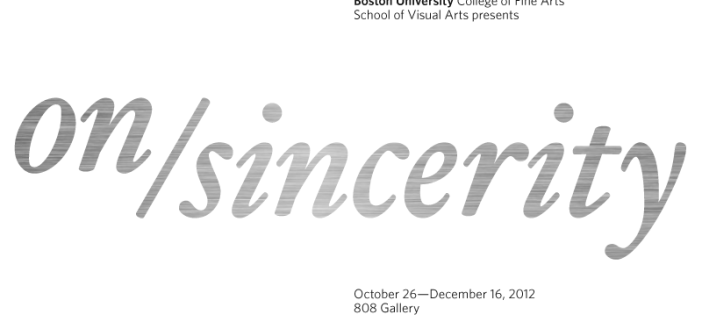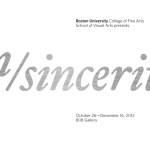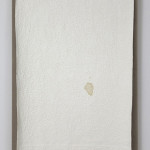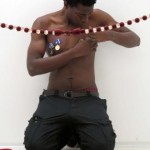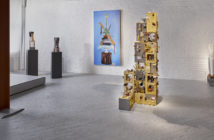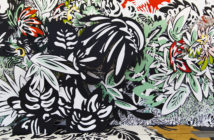Irony has long associated with hollowness in contemporary culture. "Irony was the final polish of the shoe, the ultimate dab of the clothes-brush," writes F. Scott Fitzgerald of Antony Patch, the doomed protagonist of his 1922 novel, The Beautiful and the Damned. More recently, in October, Camille Paglia treated us to a little teaser of her then-forthcoming Glittering Images with "How Capitalism Can Save Art" in The Wall Street Journal. "The vulnerability of students and faculty alike to factitious theory about the arts is in large part due to the bourgeois drift of the last half century," writes Paglia. And just a few weeks ago, in an op-ed for the New York Times, Princeton professor Christy Wampole attacked hipsters and their irony infused lifestyles. Irony "signals a deep aversion to risk…As a function of fear and pre-emptive shame, ironic living bespeaks cultural numbness, resignation and defeat," she writes.
None of the many artists included in the 808 Gallery’s On/Sincerity are culturally numb, resigned or defeated, however. Nor are they adverse to peril, physical or mental. The artists in On/Sincerity aren’t weak, and especially not towards theoretical posturing. They are artists who confront the connected questions of permanence, purpose, practice and craft at the forefront of contemporary art making. If these artists are vulnerable, it’s towards their audience. "By consciously seeking to narrow the distance between the viewer and their artwork, these artists generate honest and meaningful connections that resonate throughout the exhibition space," write the curators, Lynne Cooney, Exhibitions Director at BU’s School of Visual Arts and Liz Munsell, Assistant Curator of Contemporary Art and MFA Programs at the Museum of Fine Arts, Boston.
Douglas Weathersby’s sprawling tree-house of an installation, 808 Gallery Storage Project (2012), anchors the show. Enormous and reminiscent of Tracey Emin’s Knowing My Enemy (2002), 808 Gallery Storage Project is the product of a clean-out of School of Visual Arts’ storage, or a trove of decades-old unclaimed student paintings. These art works were once significant; they represented a grade, if nothing else. But then they were forgotten, relegated to being unknown and unseen until Weathersby, who supports himself through his environmental services company, recovered and related them to each other via two-by-fours in an interconnected structure that recalls Alfred H. Barr’s The Development of Abstract Art (1936) much as it does Facebook’s iconic global map. This work is intricate, precise, yet reverberates the sense of arbitrary chance that social media interaction as well as the personal biases that can structure canon.
Video work by Ivan Argote, Jordan Tynes & Taylor McVay and Carlos Martiel articulate the structures of truth, honesty and the real in relationships. The curators’ shrewd choices of which videos require headphones to experience versus the ones allowed to harmonize throughout the space simulates social and mass media over-communication, as well as inherent distance in intimate relationships. Argote’s Altruism (2011) makes the viewer recoil as the artist passionately licks a Parisian subway-car pole, a disgusting act that questions association and difference among strangers. Argote risks his physical body through this performance, reinforcing the authenticity, or perhaps desperation, of the human need for interaction. In Feeling (2009), Argote passionately dances to the Cure’s "Close to You," playing through a small boom box, in front of a Malevich. Argote is distanced from the music and painting’s respective contexts, and the institutionalization of both is highlighted by white-cube gallery and the to-code fire extinguisher in the bottom left corner. In Birthday (2009), Argote uses his learnt French to ask a crowded elevator of all types of people to sing him "Happy Birthday." The crowd unifies and obliges, and then, presumably, continues about their day, while the videos ends with the camera’s lens gazing down towards Argote’s feet like a shy teenager might. Altruism, Feeling and Birthday form a trio of videos that investigate the mediation of human emotion through communication, action and expression, and all require headphones. Thus the viewer is drawn into the video’s mounted small-screen as if they are a removed participant in the performance. The most effective exploitation of this is McVay & Tynes’s Conversation Piece (2010), in which the artists, a couple on the verge of a kiss, discuss Nicolas Bourriaud’s The Radicant. The video is closely-cropped, so the viewer sees just the pair’s eyes, nose and mouth—from far away, it’s like seeing couple on the train, squished together and possibly discussing dinner options. Up close and with audio, the viewer becomes a silent third-participant in their conversation, experiencing the struggles of intellectual intimacy in romantic relationships, but also possibly representing a threat to that intimacy. Similarly, in his short and silent Prodigal Son (2010), Martiel examines the dual nature of public and private life. Martiel performs a military ritual by directly pinning his father’s military medals into his own skin, a stunning recital evoking not only the private aspect to public ideologies, but personal sacrifice publicly celebrated through ceremony, and enacted in battle. Furthermore, Martiel’s wince inducing performance suggests the physical pain that soldiers bear in order to protect ideas and people, as well as the distancing consequences that that pain wrecks in personal relationships.
Martiel’s video is installed alongside Wayne Stokes’s Untitled Verso 1-3 (all 2012), presented here as a triptych of paintings that depict, with an AbEx flourish, details from the back of his family photos. These reference high modernism and the parameters of painting and formalism as much as Suara Welitoff’s neighboring Untitled (2010) and Analia Saban’s Two Stripe Bath Towel with Tag and Stain. Together these works explore how memory is created, preserved and continued through high and low culture.
Despite the pocketed, maze-ish feeling of the 808, in On/Sincerity Cooney and Munsell have seamlessly assembled artworks that critique irony, or are earnest to the core. Cumulatively, On/Sincerity probes the relationship between artist and viewer by investigating the charge of human connection realized through image, practice and material. It’s fitting that Cooney and Munsell collaborated to produce this exhibition. With its title implying both proximity and honesty, this show expresses the complexities of language and communication that inform our irony-imbued culture. Perhaps the best example of this is Platform2’s installation Failure Support Group, which both sincerely and humorously observes that the financial success available to Baby Boomers, like Paglia, and GenExers like Wampole, is starkly inaccessible to Millennials. On/Sincerity is an unassuming exhibition, but multifaceted. It provokes as many topical complexities as it reconciles in both art making and culture today.
- Analia Saban | Two Stripe Bath Towel with Tag and Stain, 2012, Acrylic on canvas. 30 x 46 x 4 inches. Courtesy the artist and Tanya Bonakdar Gallery, New York.
- Prodigal Son, Carlos Martiel Delgado Sainz House Witch, Liverpool. UK ©Photo: Alex Panda

